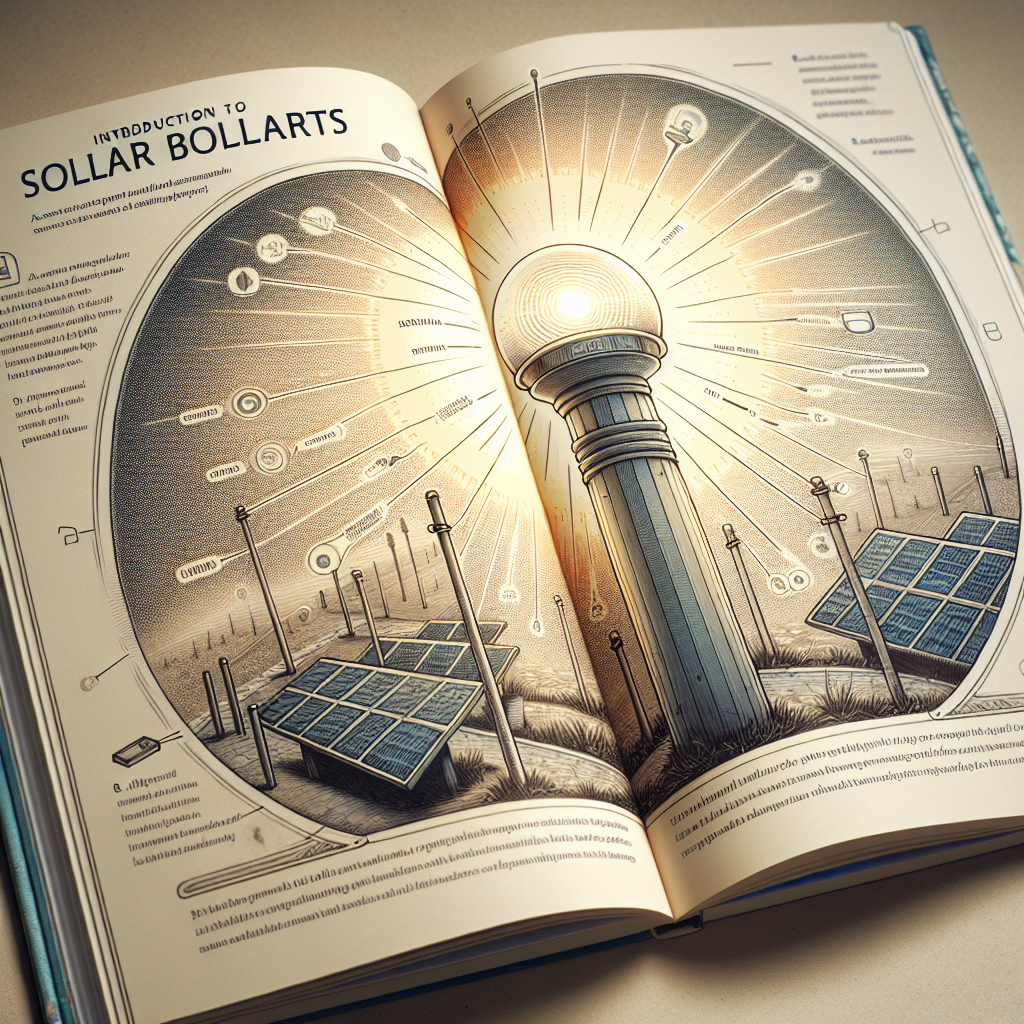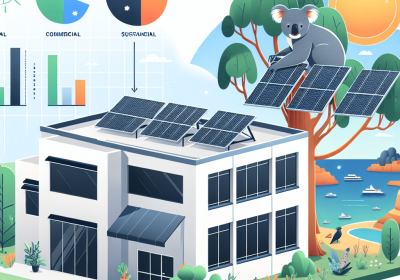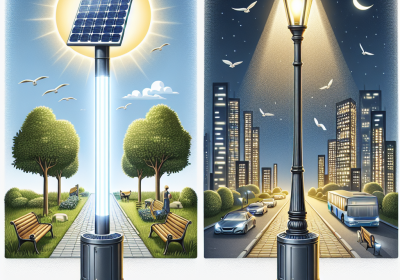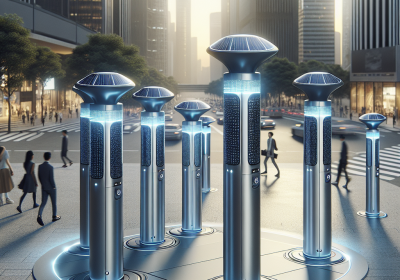How Do Solar Bollards Work?
Table of Contents
Solar bollards are self-contained outdoor lighting fixtures that harness solar energy to provide illumination. They consist of a solar panel, rechargeable battery, LED light, and a control system. During the day, the solar panel absorbs sunlight and converts it into electrical energy, which is stored in the battery. As night falls, the control system detects the decrease in ambient light and automatically activates the LED light, using the stored energy to provide illumination. This cycle repeats daily, making solar bollards an efficient and eco-friendly lighting solution for pathways, gardens, and public spaces.
Understanding The Technology Behind Solar Bollards
Solar bollards are an innovative and environmentally friendly solution for outdoor lighting, combining the principles of solar energy with modern lighting technology. To understand how solar bollards work, it is essential to delve into the components and mechanisms that enable their functionality. At the core of solar bollards is the photovoltaic (PV) panel, which is responsible for capturing sunlight and converting it into electrical energy. These panels are typically made from silicon-based materials that exhibit the photovoltaic effect, a process where light photons dislodge electrons, creating an electric current.
Once the PV panel captures sunlight, the generated electrical energy is stored in a rechargeable battery housed within the bollard. This battery is crucial for the operation of solar bollards, as it ensures that the stored energy can be used to power the light during nighttime or periods of low sunlight. The type of battery used can vary, but lithium-ion batteries are commonly preferred due to their high energy density, long lifespan, and efficiency.
Transitioning from energy storage to illumination, the stored electrical energy is used to power light-emitting diodes (LEDs) within the bollard. LEDs are chosen for their energy efficiency, longevity, and ability to produce bright light with minimal power consumption. The integration of LEDs ensures that solar bollards can provide consistent and reliable lighting throughout the night, even in areas with limited sunlight exposure during the day.
To optimize energy usage and extend the operational life of the battery, solar bollards are equipped with smart control systems. These systems often include sensors that detect ambient light levels, automatically turning the LEDs on at dusk and off at dawn. Additionally, some advanced models incorporate motion sensors that activate the light only when movement is detected, further conserving energy and enhancing security.
The design and placement of solar bollards also play a significant role in their effectiveness. The PV panels must be positioned to receive maximum sunlight exposure, typically facing south in the northern hemisphere and north in the southern hemisphere. The angle of the panels is also adjusted to match the latitude of the installation site, ensuring optimal energy capture throughout the year. Furthermore, the bollards are constructed from durable materials such as stainless steel or aluminum, which can withstand harsh weather conditions and provide long-term reliability.
In terms of environmental impact, solar bollards offer several advantages over traditional wired lighting systems. By harnessing renewable solar energy, they reduce dependence on fossil fuels and decrease greenhouse gas emissions. Additionally, the self-contained nature of solar bollards eliminates the need for extensive wiring and trenching, minimizing disruption to the surrounding landscape and reducing installation costs.
Moreover, the maintenance requirements for solar bollards are relatively low. The absence of external wiring reduces the risk of electrical faults, and the long lifespan of LEDs and lithium-ion batteries means that replacements are infrequent. Regular cleaning of the PV panels to remove dust and debris is typically sufficient to ensure optimal performance.
In conclusion, solar bollards represent a sophisticated blend of photovoltaic technology, energy storage, and efficient lighting. By capturing and storing solar energy, they provide a sustainable and cost-effective solution for outdoor illumination. The integration of smart control systems and durable construction further enhances their functionality and reliability, making them an ideal choice for a wide range of applications. As the world continues to prioritize sustainability, the adoption of solar bollards is likely to increase, contributing to a greener and more energy-efficient future.
Key Components Of Solar Bollard Systems

Solar bollards are an innovative and environmentally friendly solution for outdoor lighting, combining functionality with sustainability. Understanding the key components of solar bollard systems is essential to appreciate how they operate and the benefits they offer. At the heart of these systems are several integral parts that work in unison to harness solar energy and convert it into reliable illumination.
The primary component of a solar bollard is the solar panel, which is typically mounted on the top of the bollard. These panels are made up of photovoltaic cells that capture sunlight and convert it into electrical energy. The efficiency of the solar panel is crucial, as it determines how much sunlight can be converted into usable power. High-quality panels are designed to maximize energy absorption even in low-light conditions, ensuring that the bollard can function effectively throughout the year.
Transitioning from the solar panel, the next critical component is the battery. The energy captured by the solar panel is stored in a rechargeable battery, usually located within the bollard’s housing. This battery is designed to store enough energy to power the light during nighttime or periods of low sunlight. The capacity and lifespan of the battery are vital considerations, as they directly impact the duration and reliability of the lighting provided by the bollard. Advanced batteries, such as lithium-ion, are often used due to their high energy density and long cycle life.
Another essential element is the LED light source. LEDs are preferred in solar bollard systems because of their energy efficiency and long lifespan. They require significantly less power compared to traditional incandescent bulbs, making them ideal for use with solar energy. The LED light is typically designed to emit a specific color temperature, providing clear and consistent illumination that enhances visibility and safety in outdoor spaces.
To ensure the system operates seamlessly, a charge controller is incorporated into the design. This device regulates the flow of electricity between the solar panel, battery, and LED light. It prevents overcharging of the battery, which can lead to reduced battery life or damage, and also ensures that the LED light receives a steady and appropriate amount of power. The charge controller plays a crucial role in maintaining the overall efficiency and longevity of the solar bollard system.
In addition to these core components, many solar bollard systems include sensors that enhance their functionality. For instance, a photoresistor or light sensor can detect ambient light levels and automatically turn the LED light on at dusk and off at dawn. This automation not only conserves energy but also provides convenience and reliability. Some advanced systems may also incorporate motion sensors, which activate the light only when movement is detected nearby, further optimizing energy usage.
The integration of these components results in a self-sustaining lighting solution that requires minimal maintenance. Solar bollards are designed to withstand various weather conditions, with durable materials and weatherproof construction ensuring long-term performance. The combination of solar panels, batteries, LED lights, charge controllers, and sensors creates a cohesive system that delivers consistent and eco-friendly illumination.
In conclusion, the key components of solar bollard systems work together harmoniously to capture, store, and utilize solar energy efficiently. From the solar panel and battery to the LED light and charge controller, each element plays a vital role in ensuring the system’s effectiveness and sustainability. By understanding these components, one can better appreciate the technological advancements that make solar bollards a practical and environmentally responsible choice for outdoor lighting.
Benefits And Applications Of Solar Bollards
Solar bollards, a type of outdoor lighting solution, have gained significant attention due to their numerous benefits and versatile applications. These self-contained units harness solar energy to provide illumination, making them an eco-friendly and cost-effective alternative to traditional lighting systems. The benefits of solar bollards are manifold, ranging from environmental advantages to practical applications in various settings.
One of the primary benefits of solar bollards is their contribution to environmental sustainability. By utilizing solar energy, these bollards reduce the reliance on fossil fuels, thereby decreasing greenhouse gas emissions. This shift towards renewable energy sources is crucial in combating climate change and promoting a greener planet. Additionally, solar bollards operate independently of the electrical grid, which means they do not contribute to the depletion of non-renewable energy resources. This independence also makes them an ideal solution for remote or off-grid locations where access to electricity may be limited or non-existent.
In addition to their environmental benefits, solar bollards offer significant cost savings. Traditional lighting systems often incur high installation and maintenance costs, including wiring, trenching, and ongoing electricity expenses. In contrast, solar bollards require minimal installation effort, as they do not need to be connected to the electrical grid. This not only reduces initial setup costs but also eliminates the need for extensive maintenance. The long lifespan of LED bulbs used in solar bollards further contributes to cost savings, as they require less frequent replacement compared to conventional lighting options.
The versatility of solar bollards extends to their wide range of applications. They are commonly used in public spaces such as parks, pathways, and pedestrian areas, where they enhance safety and visibility. By providing consistent and reliable lighting, solar bollards help prevent accidents and deter criminal activities, thereby promoting a sense of security among residents and visitors. Moreover, their aesthetic appeal adds to the overall ambiance of public spaces, creating a welcoming and pleasant environment.
Solar bollards are also well-suited for commercial and residential properties. In commercial settings, they can be used to illuminate parking lots, driveways, and building perimeters, ensuring safe navigation for employees and customers. For residential properties, solar bollards offer an attractive and functional lighting solution for gardens, walkways, and patios. Their unobtrusive design allows them to blend seamlessly with various architectural styles, enhancing the overall curb appeal of the property.
Furthermore, solar bollards are an excellent choice for temporary or seasonal installations. Events such as festivals, outdoor weddings, and holiday displays can benefit from the flexibility and ease of deployment that solar bollards provide. Since they do not require a permanent power source, they can be easily relocated and adjusted to suit the specific needs of the event. This adaptability makes them a practical and efficient lighting solution for a variety of occasions.
In conclusion, the benefits and applications of solar bollards are extensive and varied. Their environmental advantages, cost savings, and versatility make them an attractive option for a wide range of settings. By harnessing the power of the sun, solar bollards offer a sustainable and efficient lighting solution that enhances safety, security, and aesthetic appeal. As the demand for renewable energy continues to grow, solar bollards are poised to play a significant role in the future of outdoor lighting.
Table of Contents
Solar bollards are innovative outdoor lighting solutions that harness solar energy to provide illumination in various settings, such as pathways, gardens, parks, and commercial spaces. These self-contained units integrate solar panels, rechargeable batteries, and LED lights into a single, durable structure, offering an eco-friendly and cost-effective alternative to traditional wired lighting systems. By converting sunlight into electrical energy during the day and automatically activating at dusk, solar bollards ensure consistent, low-maintenance lighting while reducing energy consumption and minimizing environmental impact. Their ease of installation, coupled with advancements in solar technology and design, makes solar bollards an increasingly popular choice for enhancing safety, aesthetics, and sustainability in outdoor environments.
Benefits Of Using Solar Bollards In Urban Landscaping
Solar bollards, increasingly prevalent in urban landscaping, offer a multitude of benefits that extend beyond mere illumination. These innovative lighting solutions harness solar energy, providing an eco-friendly alternative to traditional electric lighting. As cities strive to become more sustainable, the integration of solar bollards into urban landscapes is a step forward in reducing carbon footprints and promoting environmental stewardship.
One of the primary advantages of solar bollards is their energy efficiency. By utilizing solar panels to capture and convert sunlight into electricity, these bollards operate independently of the power grid. This autonomy not only reduces energy consumption but also lowers utility costs for municipalities and property owners. Furthermore, the reliance on renewable energy sources diminishes the demand for fossil fuels, thereby contributing to a reduction in greenhouse gas emissions. Consequently, solar bollards play a crucial role in mitigating climate change and fostering a greener urban environment.
In addition to their environmental benefits, solar bollards offer significant economic advantages. The initial investment in solar bollards may be higher compared to traditional lighting systems; however, the long-term savings are substantial. Since solar bollards do not require electrical wiring, installation costs are considerably lower. Moreover, the maintenance expenses are minimal, as these bollards are designed to be durable and weather-resistant. The absence of ongoing electricity bills further enhances their cost-effectiveness, making them an attractive option for budget-conscious urban planners and developers.
Beyond the financial and environmental aspects, solar bollards contribute to the aesthetic appeal of urban landscapes. Available in a variety of designs and finishes, they can seamlessly blend into different architectural styles and enhance the visual harmony of public spaces. The soft, ambient light emitted by solar bollards creates a welcoming atmosphere, improving the overall experience for pedestrians and visitors. This enhanced ambiance not only promotes a sense of safety and security but also encourages outdoor activities, thereby fostering a vibrant community life.
Moreover, solar bollards are equipped with advanced technology that ensures reliable performance. Many models feature built-in sensors that automatically adjust the light intensity based on ambient conditions, optimizing energy usage and extending battery life. Additionally, the use of LED bulbs in solar bollards provides bright and consistent illumination while consuming minimal power. These technological advancements ensure that solar bollards remain functional even during cloudy days or extended periods of low sunlight, thereby guaranteeing uninterrupted service.
The versatility of solar bollards further underscores their value in urban landscaping. They can be strategically placed along pathways, in parks, around public buildings, and in parking lots to enhance visibility and guide pedestrians. Their application is not limited to public spaces; private properties, such as residential complexes and commercial establishments, can also benefit from the installation of solar bollards. This adaptability makes them a practical solution for a wide range of lighting needs, contributing to the overall safety and functionality of urban areas.
In conclusion, the benefits of using solar bollards in urban landscaping are manifold. Their energy efficiency, economic viability, aesthetic appeal, technological reliability, and versatility make them an ideal choice for modern cities aiming to achieve sustainability goals. As urban areas continue to grow and evolve, the adoption of solar bollards represents a forward-thinking approach to creating environmentally responsible and visually pleasing public spaces. By embracing this innovative lighting solution, cities can pave the way for a brighter, greener future.
How Solar Bollards Work: A Comprehensive Guide

Solar bollards are an innovative and environmentally friendly solution for outdoor lighting, combining functionality with sustainability. These devices harness solar energy to provide illumination, making them an ideal choice for pathways, gardens, parks, and other outdoor spaces. Understanding how solar bollards work involves delving into the components that make up these devices and the processes they undergo to convert sunlight into usable light.
At the core of a solar bollard is the solar panel, typically located at the top of the unit. This panel is composed of photovoltaic cells, which are responsible for capturing sunlight and converting it into electrical energy. The efficiency of this conversion process is crucial, as it determines how much energy can be stored and subsequently used for lighting. Modern solar panels are designed to maximize energy capture even in low-light conditions, ensuring that the bollards remain functional throughout varying weather patterns.
Once the solar energy is captured, it is stored in a rechargeable battery housed within the bollard. These batteries are usually lithium-ion due to their high energy density and long lifespan. The storage capacity of the battery is a critical factor, as it dictates how long the bollard can provide illumination during periods without sunlight, such as nighttime or cloudy days. Advanced solar bollards are equipped with energy management systems that optimize the charging and discharging cycles of the battery, thereby extending its operational life and ensuring consistent performance.
The stored energy is then used to power the light-emitting diode (LED) lights within the bollard. LEDs are chosen for their high efficiency and longevity, consuming significantly less power compared to traditional incandescent bulbs while providing bright and clear illumination. The design of the LED array within the bollard is also important, as it affects the distribution and intensity of the light. Many solar bollards feature diffusers or reflectors to ensure even light dispersion, enhancing visibility and safety in the illuminated area.
In addition to these primary components, solar bollards often incorporate sensors and control systems to enhance their functionality. For instance, many models are equipped with photoresistors or light sensors that detect ambient light levels. These sensors enable the bollards to automatically turn on at dusk and off at dawn, conserving energy and reducing the need for manual intervention. Some advanced models also include motion sensors, which activate the lights only when movement is detected nearby, further optimizing energy usage and extending battery life.
The integration of these components and systems results in a self-sustaining lighting solution that requires minimal maintenance. However, it is important to consider factors such as the placement and orientation of the solar bollards to maximize their efficiency. Ideally, they should be installed in locations with ample sunlight exposure and minimal shading from trees or buildings. Regular cleaning of the solar panels is also recommended to ensure optimal energy capture.
In conclusion, solar bollards represent a sophisticated blend of technology and design, offering a sustainable and efficient alternative for outdoor lighting. By harnessing solar energy, storing it effectively, and utilizing it through efficient LED lights, these devices provide reliable illumination while minimizing environmental impact. As technology continues to advance, we can expect further improvements in the efficiency and functionality of solar bollards, making them an increasingly attractive option for a wide range of applications.
Installation And Maintenance Tips For Solar Bollards
Solar bollards are an increasingly popular choice for outdoor lighting, offering an eco-friendly and cost-effective solution for illuminating pathways, gardens, and public spaces. Their installation and maintenance, while relatively straightforward, require careful attention to detail to ensure optimal performance and longevity. This article provides essential tips for the installation and maintenance of solar bollards, guiding you through the process to achieve the best results.
To begin with, selecting the appropriate location for your solar bollards is crucial. These devices rely on sunlight to charge their batteries, so it is imperative to place them in areas that receive ample sunlight throughout the day. Avoid locations that are heavily shaded by trees, buildings, or other structures, as insufficient sunlight can significantly reduce the efficiency of the solar panels. Additionally, consider the purpose of the lighting and ensure that the bollards are positioned to provide adequate illumination for pathways or specific areas that require lighting.
Once you have identified the ideal locations, the next step is to prepare the installation site. This involves clearing the area of any debris, rocks, or vegetation that might obstruct the installation process. It is also advisable to mark the exact spots where the bollards will be installed, ensuring uniform spacing and alignment. Proper site preparation not only facilitates a smoother installation but also contributes to the overall aesthetic appeal of the lighting arrangement.
The actual installation process varies depending on the design and model of the solar bollards. Generally, it involves securing the bollard base into the ground, which can be done using ground spikes, concrete anchors, or other mounting hardware provided by the manufacturer. It is essential to follow the manufacturer’s instructions meticulously to ensure a stable and secure installation. For installations in areas with loose or sandy soil, additional measures such as using longer spikes or adding a concrete base may be necessary to prevent the bollards from tilting or becoming unstable over time.
After installation, regular maintenance is key to ensuring the longevity and efficiency of solar bollards. One of the primary maintenance tasks is cleaning the solar panels. Dust, dirt, and debris can accumulate on the panels, obstructing sunlight and reducing their charging capacity. Cleaning the panels with a soft cloth and mild detergent periodically can help maintain their efficiency. It is also important to inspect the bollards for any signs of damage or wear, such as cracks in the housing or corrosion on the metal parts. Addressing these issues promptly can prevent further deterioration and extend the lifespan of the bollards.
In addition to cleaning and inspections, battery maintenance is another critical aspect. Most solar bollards are equipped with rechargeable batteries that store energy collected by the solar panels. Over time, these batteries may lose their capacity to hold a charge and may need to be replaced. Monitoring the performance of the bollards and replacing the batteries as needed can ensure consistent lighting performance. It is advisable to use high-quality replacement batteries recommended by the manufacturer to achieve the best results.
In conclusion, the installation and maintenance of solar bollards are essential steps to ensure their effective operation and longevity. By carefully selecting the installation site, following proper installation procedures, and performing regular maintenance tasks, you can enjoy the benefits of sustainable and efficient outdoor lighting for years to come.
Read more about Solar Bollards:
- Introduction to Solar Bollards
- Design and Aesthetics of Solar Bollards
- Maintenance and Durability of Solar Bollards
- Applications of Solar Bollards
- Choosing the Right Solar Bollard for Your Needs
- Installation and Wiring of Solar Bollards
- Integration of Solar Bollards with Smart Technology
- Comparison of Solar Bollards with Traditional Lighting Solutions
- Regulations and Standards for Solar Bollards








